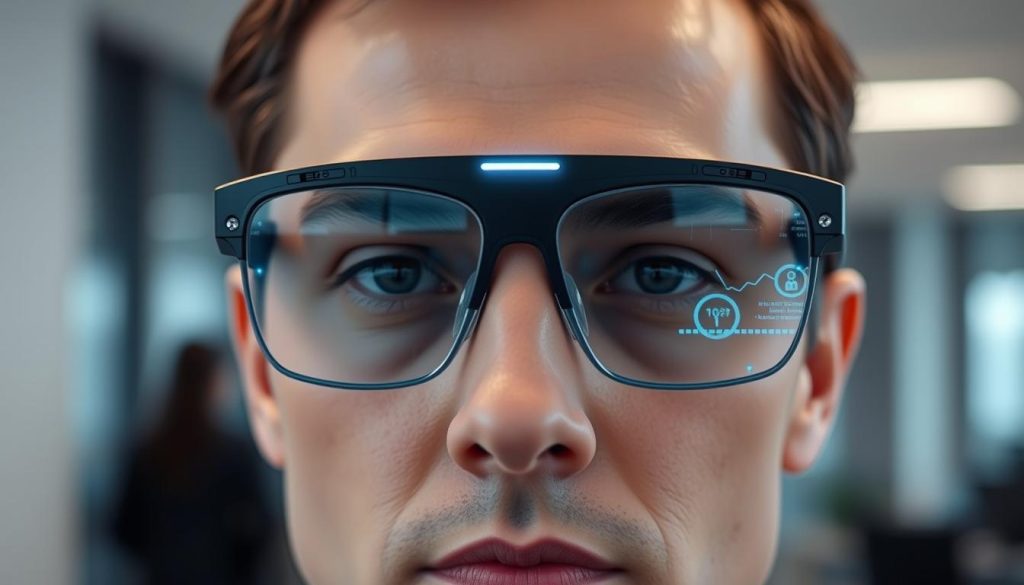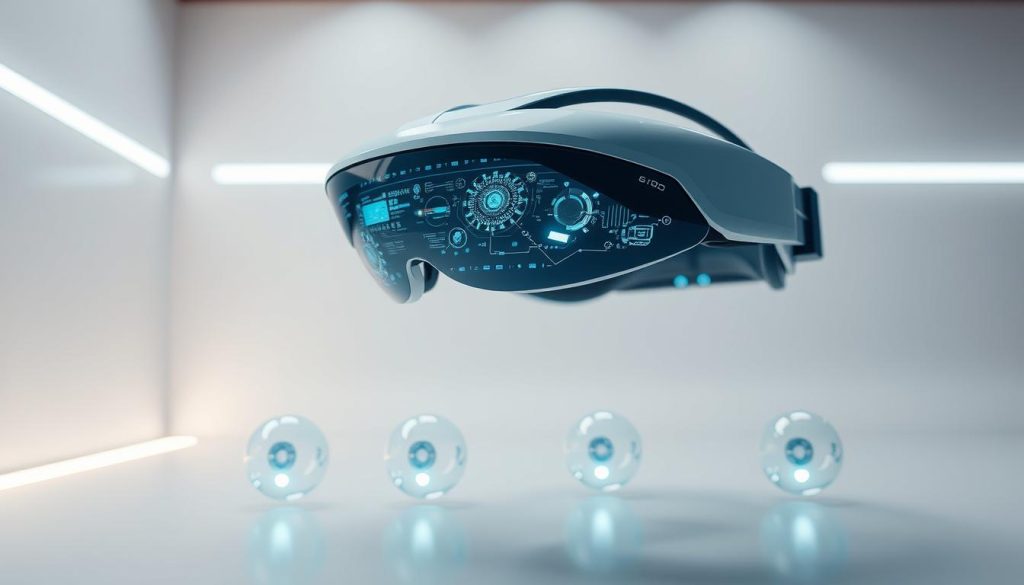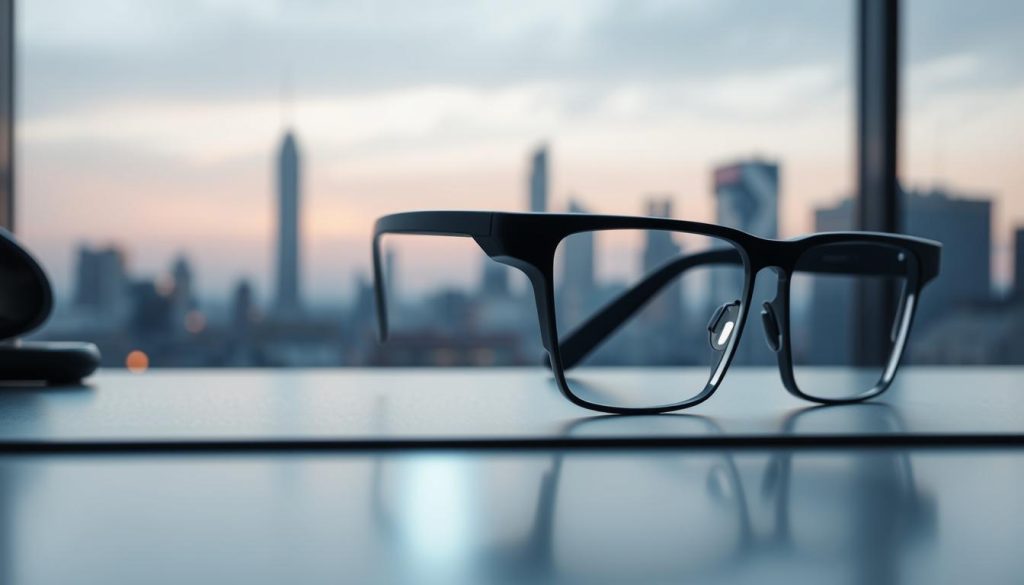Smart Glasses are changing how we live by combining Wearable Tech Glasses with new features. They are used in fields like manufacturing and healthcare. These devices give users hands-free access to data and safety features.
They also provide real-time insights. From helping surgeons to making factory workers more productive, their benefits are wide-ranging. They impact work, learning, and health tracking.
Top models like the RealWear Navigator 500 and HoloLens 2 show the mix of practicality and innovation. Prices vary from a few hundred to thousands of dollars. This makes them available to both professionals and consumers.
Brands like Vuzix and Google are focusing on design and function. Meta’s Ray-Ban smart glasses have sold over 1 million units last year. This shows their growing popularity.
Key Takeaways
- Smart Glasses improve workplace safety and efficiency in industries like logistics and healthcare.
- Healthcare professionals use them for hands-free patient data access during surgeries.
- Global sales are projected to push the market toward $20 billion by 2025.
- Devices like the Emteq Labs’ Sense track eating habits and mood through facial sensors, providing deeper health insights.
- Upcoming models, such as Google’s Android XR glasses, aim to advance display technology and connectivity.
Understanding Smart Glasses: The Future of Wearable Technology
Smart glasses change how we use technology. They mix advanced computing with regular glasses, giving us features we never had before. By 2025, the digital eyewear market will reach $19.15 billion. It’s expected to grow to $59 billion by 2030, thanks to Augmented Reality and AI.
What Exactly Are Smart Glasses?
Smart glasses are like wearable computers in glasses. They have small screens, cameras, sensors, and processors. Imagine seeing messages or directions right in front of you.
These glasses connect to the internet quickly. For example, Augmented Reality Eyewear like Microsoft’s HoloLens 2 helps surgeons and engineers by showing 3D models.
The Evolution of Digital Eyewear
The journey of digital eyewear has been amazing. Early versions were big and had short battery life. Now, we have sleek designs like Vuzix Blade 3 or Ray-Ban Stories by Meta.
These glasses use waveguide displays and AI cameras. Magic Leap’s light field tech and MicroLED screens make visuals clearer and last longer.
How Smart Glasses Differ from Traditional Eyewear
- Augmented Reality: Smart glasses add digital info to the real world, unlike regular glasses.
- Connectivity: They have 5G/Wi-Fi for streaming and cloud processing.
- AI & Sensors: Cameras and AI recognize objects, translate languages, or guide navigation.
This tech isn’t just for tech fans. It’s also for people with disabilities, who prefer inclusive tech. Smart glasses show us a smarter world.
Key Benefits of Smart Glasses in Your Daily Life
Smart Eyeglasses combine technology and practicality to make life easier. Imagine getting directions while driving or checking work data without stopping. These devices offer hands-free use and real-time information, making daily tasks simpler.
- Work Smarter: Professionals work more efficiently—surgeons get patient data during surgeries, and engineers fix things faster with AR.
- Health & Accessibility: Over 285 million people with vision issues benefit from text-to-speech and magnification. Seniors find 75% better organization with reminders for meds and appointments.
- Safety & Independence: GPS and emergency alerts cut response times by 40% in emergencies. 80% of users feel safer with these features.
Smart Eyeglasses also improve life quality beyond work. They are compatible with prescriptions for 70% of users. Real-time health tracking helps users reach fitness goals 25% faster. For those with chronic conditions, personalized alerts make healthcare routines easier.
The global market for these devices is growing at 20.4% annually, showing increasing demand. Over 50% of users say smart eyeglasses reduce screen time and neck strain from phones. As technology advances, these gadgets offer more personalized solutions, from AR learning tools to hands-free communication. They are key for staying connected without losing mobility.
Augmented Reality Features That Transform Your Perspective
Imagine walking through a new city with digital directions guiding you. Or seeing real-time translations on street signs. AR Glasses blend virtual and real worlds, changing how we interact. They use cameras, sensors, and AI to add data to our surroundings, making things easier to understand.
Visual Overlays and Information Display
AR Glasses like the Rokid Max show clear visuals right in your sight. For example, repair manuals can appear above machinery, or weather forecasts next to your coffee. The XReal Air 2 Ultra even has fixed virtual screens, keeping content steady as you move.
Navigation and Direction Assistance
No more holding a phone for maps. AR Glasses show directions right on the path ahead. The NCL RayNeo X2 highlights landmarks and distances, while the Meta Ray-Ban Stories takes photos and videos quietly during walks. These features reduce screen time and improve awareness of your surroundings.
Real-time Translation and Communication
Traveling? The Rokid Max instantly translates menus or signs into your language. During calls, some models like the Amazon Echo Frames show spoken words as subtitles in real time, helping to bridge language gaps.
| Feature | Rokid Max | XReal Air 2 Ultra | NCL RayNeo X2 |
|---|---|---|---|
| Display Size | 215″ virtual screen | Fixed virtual screens | Two 1080p screens |
| Battery Life | 5 hours | 6 hours | 8 hours |
| Translation Support | 40+ languages | Real-time subtitles | OCR text scanning |
How Smart Glasses Enhance Productivity and Efficiency
70% of firms report that Smart Wearable Glasses improve business resilience through hands-free multitasking and real-time data access.
Smart Wearable Glasses change how we work by combining tech with easy use. You can manage tasks without touching a screen. Voice commands let you access manuals, send messages, or follow steps while your hands are free.
These devices make downtime into time for getting things done.
Hands-free Operation for Multitasking
- Teleprompter modes display notes during presentations, keeping you engaged with audiences.
- Gesture controls let you adjust settings or capture data mid-task, reducing workflow interruptions.
Work Applications and Professional Use Cases
Healthcare and logistics lead in using these glasses. Mayo Clinic surgeons use AR to see patient scans during surgery. Vuzix AR models help factory workers, cutting errors by 30%.
Ray-Ban Meta glasses let field technicians show problems to experts live, cutting down on solving times.
Time-saving Features You’ll Appreciate
Training with Smart Wearable Glasses cuts onboarding time by 40%. DigiLens ARGO’s 48MP display helps engineers work together in real-time, no more emails back and forth. With 93% of industrial firms using these tools, efficiency gains are clear.
One logistics firm cut delivery errors by 25% with AR-guided packing instructions.
Entertainment and Lifestyle Applications of Smart Eyeglasses
Smart Glasses are changing how we enjoy entertainment and daily life. Imagine watching a virtual movie on a huge screen while you’re on the move. Or playing games that mix digital and real-world elements. These devices bring you closer to the action without cutting you off from reality.
“Over 50% of visually impaired users of smart glasses like the OrCam MyEye report increased independence and better navigation.”
Entertainment options are endless. Stream shows without using your hands, get real-time translations while traveling, or dive into interactive educational content. For instance, cooking becomes simpler with step-by-step guides right in your view, letting your hands stay free. Shopping also gets a boost—just scan products to see reviews or compare prices instantly with AR overlays.
- Watch movies or shows via virtual screens during commutes
- Play AR games that blend digital elements with real environments
- Access fitness metrics like heart rate or calories burned during workouts
- Get real-time language translations during conversations
These devices also make daily tasks easier. Over 65% of users want models that fit their prescription, combining style with practicality. Fitness fans track their progress easily, and travelers navigate cities with turn-by-turn directions. The market’s growth rate of 29.4% shows how much people want these features.
As AI gets better, expect more tailored advice and adaptive interfaces. With 5G, data streams in real-time, making everything from workouts to socializing better. Smart Glasses are more than gadgets—they’re tools for a smarter, more enjoyable life.
Privacy and Security Considerations for Wearable Tech Glasses
Wearable Tech Glasses, like Meta and Ray-Ban’s latest, come with cool features. But, their cameras and data collection make us wonder about privacy. Over 70% of users don’t check their privacy settings, leaving their data at risk. Features like real-time recording are handy but need to be used wisely to avoid misuse.

- Encryption: Only 30% of users enable device encryption, a critical step to protect data.
- 2FA: Two-factor authentication reduces unauthorized access but is underused.
- Updates: Regular firmware updates patch security gaps, yet adoption varies by brand.
Legal rules like the EU’s GDPR and the UK’s Product Security Act push for openness. Companies must keep data private and get consent for health info, like heart rate. Fitness models, which track health, make things even more complex.
“Privacy starts with you. Review settings, limit public use, and stay informed about data policies.”
Smart glasses with live recording indicators, like the LED light on newer models, tell others when recording. Always turn off devices in private areas and respect others’ wishes. Training programs, like Haekka’s, show a 75% cost drop in breaches with the right steps. Keep your privacy by adjusting settings and avoiding unsecured Wi-Fi.
Comparing Popular Smart Glasses Models on the Market
Choosing the right Smart Glasses or AR Glasses depends on your budget and goals. Look at the differences between top models to find what suits you best.
Premium Options and Their Distinctive Features
Flagship models offer advanced features but cost more. For example:
| Model | Price | Key Features | Use Cases |
|---|---|---|---|
| Microsoft HoloLens 2 | $3,500 | Enterprise-grade AR, 2000×1832 resolution | Industrial training, medical imaging |
| Xreal One | $399 | 147″ ultra-wide display, 50° field of view | AR entertainment, spatial computing |
| Viture Pro XR | $549 | 4,000 nits brightness, hybrid AR/VR | Professional design, gaming |
Budget-friendly Smart Glasses Worth Considering
Affordable options save money but might not have all the bells and whistles. For instance:
- Xreal Air: $199 with 43° FOV and 400 nits brightness
- Lucyd Glasses: $119, 8-hour battery, lightweight at 1.4 oz
- Amazon Echo Frames: $270 with Alexa voice control
Specialized Smart Glasses for Specific Activities
Activity-focused models meet specific needs:
| Model | Price | Key Feature | Best For |
|---|---|---|---|
| Solos AirGo 3 | $249 | 2-hour battery for fitness tracking | Workouts |
| Ray-Ban Meta | $299 | 12MP camera, social media sharing | Content creation |
Think about battery life—Ray-Ban’s 4-hour vs. Lucyd’s 8 hours. Also, consider AR display clarity. While AR Glasses like the Xreal One have wide fields of view, cheaper models focus on being affordable. Always check if the device works with your setup, as some lack USB-C ports.
The Future of Smart Head-Mounted Displays and Smart Contact Lenses
Imagine a world where Smart Head-Mounted Displays and Smart Contact Lenses are as common as smartphones. Meta’s next-gen smart glasses could make virtual meetings feel like teleportation. Companies like OpenBCI and RE-AK are working on brain-controlled interfaces. They aim to make our interactions with technology simpler.
- Smaller, lighter Smart Head-Mounted Displays with longer battery life could replace phones by 2030.
- Smart Contact Lenses are in early stages, aiming to project data directly into your field of vision without bulky hardware.
- 5G networks will enable real-time AR collaboration, while AI personalizes your digital overlays.

Despite the excitement, there are challenges. High costs and privacy concerns are big issues. For example, Amazon Echo Frames have poor bass and struggle with outdoor noise. Yet, the AR market is growing fast, expected to reach $198 billion by 2025.
Apple’s Vision Pro is generating interest, promising sleek designs that fit into our daily lives. But there are ethical questions. How much data will these devices collect? Ensuring privacy while innovating is key to their success. The future holds convenience, but we must choose wisely to benefit from technology.
Conclusion: Embracing the Smart Glasses Revolution
Smart glasses are now a part of our daily lives. The global AR market is expected to reach $198.17 billion by 2025. These devices change how we use technology.
Imagine using them for hands-free navigation, real-time translations, or health monitoring. These features are already available. Over 75% of users find them essential for staying connected while keeping their surroundings in mind.
Devices like OrCam MyEye have greatly helped visually impaired users, improving their independence by 40%. XRAI Glass also helped over 350 engineers at embedUR to pioneer AI solutions. The market is growing fast, with prices expected to drop by 25% by 2028.
Health care is also embracing AI, aiming to offer more personalized experiences by 60%. While privacy concerns are valid, with 70% of users worried about data security, manufacturers are working on solutions. The average battery life and accessibility features, like those at the Shine Music Festival, show progress.
AI chips are driving this growth, leading to smarter, sleeker designs. With 55% of users saying hands-free operation boosts productivity, these glasses are more than gadgets. They open doors to a more connected world.
Smart glasses are changing classrooms and healthcare. As technology improves, their role in our lives will grow. Whether you’re a professional or someone looking for new ways to stay informed, now is the time to explore their benefits. The future is wearable, and it’s becoming clearer every day.


